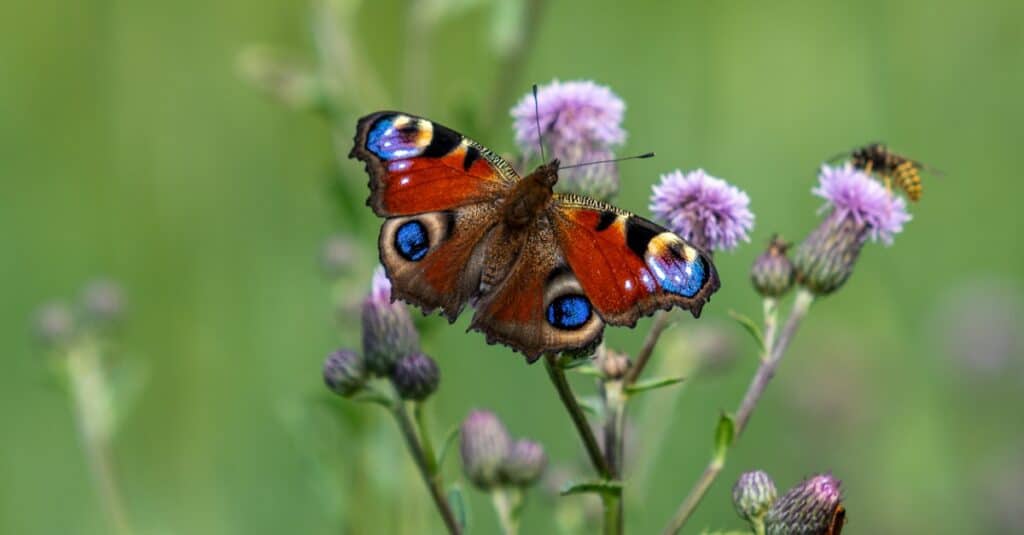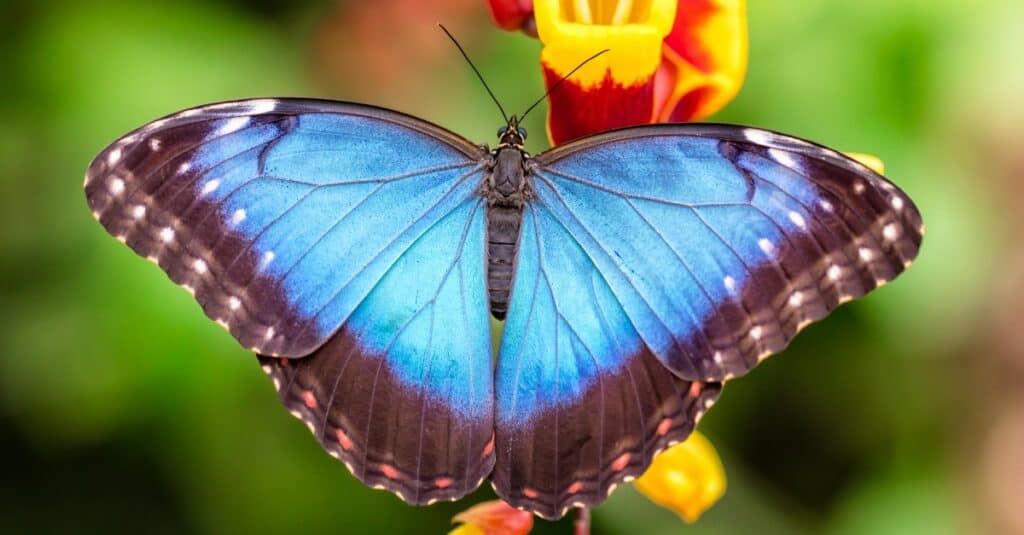key point
- Butterflies sleep differently than humans.
- Instead of sleeping, the butterfly became less active.
- Butterflies can crawl into crevices between rocks, while others sleep in dense bushes.
If you’re interested in studying butterflies, there are over 1,100 species of butterflies worldwide to choose from. Although butterflies may seem like delicate creatures, they are fast and extremely adaptable. During the day, you may have spent some time watching a butterfly move across the garden.
But have you ever wondered where these fluttering creatures sleep when they disappear at night?
Read on to find the answer to your question: Where do butterflies sleep?
Also, consider some of the details of how these insects rest and what they do as winter approaches.

Do butterflies go into deep sleep?
Butterflies sleep differently than humans. In fact, if a butterfly goes into a deep sleep, it puts itself at risk of being eaten by a predator. So instead of sleeping, the butterfly became less active
Butterflies don’t sleep, they can rest at night or during the day when it’s raining or cold. They will rest with their eyes open, are usually hidden in foliage, and often hang upside down from leaves or branches.
Scientists call this going into a state of quiescence. When it’s at rest, the butterfly is getting the rest it needs while avoiding the danger of falling into a deep sleep.
When Do Butterflies Sleep?
Butterflies are cold-blooded animals. This means they need the warmth of the sun to maintain a normal body temperature. Additionally, they need warmth to have enough energy to move their wings and fly around in search of nectar and other sources of nutrition.
So it stands to reason that butterflies rest at night when they don’t have sunlight to keep them warm.
Where do butterflies sleep?
Butterflies can sleep in many places in their habitat. Some of these insects crawl into crevices between rocks, while others sleep in dense bushes or even in hanging plants on the porch of your home.
The main thing butterflies look for when they want to sleep is protection from predators that might pass by during the night. They also want to be sheltered from possible rain during the night.
Where do butterflies sleep in winter?
Since butterflies are cold-blooded, most adult butterflies cannot survive the freezing temperatures of winter. That’s why many adult butterflies migrate to warmer locations when they sense cold weather is approaching. The monarch butterfly and the painted lady are two examples of butterflies that migrate to warmer climates. You may have heard of the monarch butterflies that flock to Mexico. But not all butterflies go elsewhere in winter.
Butterflies that linger over the winter come in other forms. Butterfly eggs, larvae (caterpillars) or pupae can survive winter weather. For example, butterfly larvae (also known as caterpillars) can burrow into the ground under piles of leaves in winter. It goes dormant until spring. Butterfly eggs and pupae are also designed to withstand the cold conditions of temperate climates.
Are there any adult butterflies that can survive cold winter weather?
Yes. An adult Mourning Cloak butterfly is able to survive winter in mild climates. These butterflies sometimes slip under tree bark or into tight spaces inside logs. Adult butterflies enter a dormant stage, spending cold weather in this refuge.

Do Butterflies Overwinter in a House?
Yes, some adult butterflies overwinter in people’s houses. It seems hard to believe, but it’s true. Two species of butterflies, the small tortoise and the peacock butterfly, are known to seek shelter in people’s homes during the winter.
These butterflies find their way into homes in late summer. The cool, dry environment of the home is very attractive to them. A crevice or dark corner in the wall is a good hiding place for adult butterflies.
The problem comes in the winter when the furnace keeps running in the home. These butterflies sense the increase in temperature and wake up from hibernation. They mistakenly think that spring is coming. However, it’s still snowing outside and it’s too cold for them to survive, so the homeowners can’t let them outside.
The scientists advise homeowners to gently place the butterflies in boxes and place the boxes in a cool room of their home. This change in temperature may send the butterflies back to dormancy. Butterflies should be kept in that cool room until spring comes and temperatures pick up. Then, when the butterfly is ready, it should be given a way out.
Do butterflies sleep in groups or alone?
both. Some types of butterflies sleep or rest in groups, while others are alone. Butterflies that sleep in groups have an advantage over those that sleep alone.
A group of butterflies may gather in a bush or hang upside down under the leaves of a mass of plants. By being close together, they can create warmth between them, which is essential for the butterfly’s survival. Second, sleeping in a colony of butterflies provides a simple and effective defense against predators.
Normally, butterflies fold their wings upward when they are resting or sleeping. If a butterfly in the colony detects a predator or other threat nearby, it spreads its wings. Its outstretched wings touched the butterfly next to it, causing that butterfly to spread its wings. This simple maneuver sends a warning signal across a swarm of butterflies so they can escape to a better resting place.
Given that these insects are near the bottom of the food chain, butterflies need all the protection they can get from predators.
Where do butterflies sleep?

Typically, butterflies rest upside down on branches or stems. If they are in dense bushes, they may simply fold their wings and become motionless. When at rest, the blue morpho butterfly folds its wings like other butterflies. However, it has many built-in advantages not found in other butterflies.
The blue morpho butterfly lives in the tropical forests of South America. It is best known for its iridescent blue wings with white spots on a black border. But when it folds its wings, it reveals a brown underside with a pattern that looks like a line of eyes.
These eyes may fool a predator into thinking it is chasing an animal that is staring at it! So when the blue morpho butterfly folds its wings at night, it provides protection in the form of wing camouflage. Of course, this camouflage is also useful in daylight.
As morning comes, butterflies spread their wings to warm themselves in the sun. Once the insect’s body temperature rises, the butterfly can move around during the day.
What are some misconceptions about butterflies and their resting behavior?
As mentioned above, monarch butterflies migrate to the warmer climate of Mexico during the winter. There are widespread misconceptions about the monarch butterfly’s trip to Mexico.
While one generation of monarch butterflies travels to Mexico in the winter, another generation returns to temperate climates in the spring. Five generations of monarch butterflies have participated in this migratory pattern.
Another misconception about butterflies is that their eyelids close to rest. In fact, butterflies don’t have eyelids.
Some people think butterflies only sleep at night. This is not correct. Butterflies may rest during the day for a variety of reasons. Thunderstorms are coming for one reason. A big drop of rain can knock a butterfly in the air.
This is dangerous because butterflies on the ground are at high risk of being attacked by predators. Also, the wings of butterflies can be damaged by raindrops. So when the wind picks up, butterflies seek shelter under leaves or in bushes. It will rest there until the storm passes.
If a butterfly gets too hot during the day, it may need some time to rest. It will choose a place under the leaves to cool off before going out to continue hunting for food.

What if you found a butterfly resting at night?
Butterflies are experts at finding great hiding places to rest at night. As a result, few people stumble across butterflies when it’s dark. However, it happens from time to time.
The best thing to do is to keep some distance between you and the insect so as not to disturb its flight. If a butterfly is disturbed during the night and tries to fly away, it is in danger of landing on the ground. It is wisest to let the butterfly sit quietly in its hiding place.

I am broadly interested in how human activities influence the ability of wildlife to persist in the modified environments that we create.
Specifically, my research investigates how the configuration and composition of landscapes influence the movement and population dynamics of forest birds. Both natural and human-derived fragmenting of habitat can influence where birds settle, how they access the resources they need to survive and reproduce, and these factors in turn affect population demographics. Most recently, I have been studying the ability of individuals to move through and utilize forested areas which have been modified through timber harvest as they seek out resources for the breeding and postfledging phases. As well I am working in collaboration with Parks Canada scientists to examine in the influence of high density moose populations on forest bird communities in Gros Morne National Park. Many of my projects are conducted in collaboration or consultation with representatives of industry and government agencies, seeking to improve the management and sustainability of natural resource extraction.










